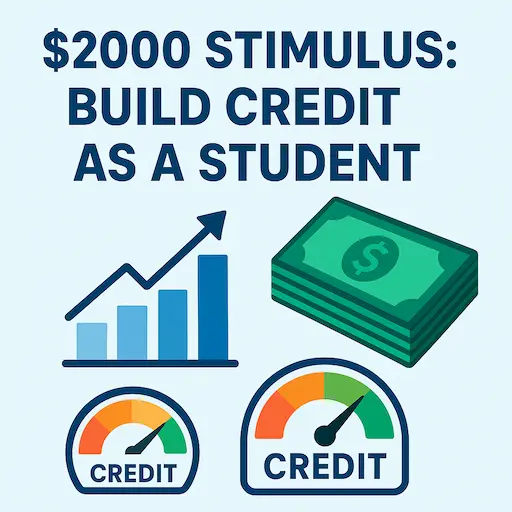
Introduction
The recent $2000 stimulus payment has been a welcome relief for many Americans, especially students who are managing tight budgets. While some may use the funds for daily expenses, others see it as a unique opportunity to build or improve their credit score.
If you’re a student with little to no credit history, this payment could be your stepping stone to financial independence. In this guide, we’ll explore how to strategically use your stimulus money to establish credit, avoid debt traps, and set yourself up for a strong financial future.
Why Building Credit Early Matters for Students
1. Access to Better Financial Products
Good credit opens doors to lower interest rates, higher credit limits, and rewards programs.
2. Easier Approval for Rentals and Loans
Landlords, lenders, and even some employers check credit reports.
3. Long-Term Savings
Higher credit scores can save you thousands of dollars over a lifetime.
Understanding the $2000 Stimulus Payment
The $2000 stimulus payment is part of a federal relief effort. While eligibility criteria vary, students who meet income requirements may qualify.
Key points:
- Eligibility: Typically based on tax filings, dependent status, and income thresholds.
- Delivery method: Direct deposit, mailed check, or prepaid debit card.
- Purpose: To provide economic relief during challenging times.
Step-by-Step Guide to Using Your $2000 to Build Credit
Step 1: Create a Financial Plan
Before spending, outline:
- Essential expenses (rent, utilities, groceries)
- Credit-building allocation (credit card deposits, loan repayments)
- Emergency savings (recommended: at least $500 set aside)
Step 2: Choose the Right Credit-Building Tool
1. Student Credit Cards
Ideal for newcomers with no credit history.
Top picks:
| Credit Card | Annual Fee | APR | Rewards | Requirements |
|---|---|---|---|---|
| Discover it® Student Cash Back | $0 | 17.99%–26.99% | 5% rotating categories | Student enrollment |
| Chase Freedom® Student | $0 | 19.99% | 1% cash back | Proof of student status |
| Capital One Quicksilver Student | $0 | 19.99%–29.99% | 1.5% cash back | No credit required |
(Tip: Use $300–$500 of your stimulus as a spending buffer to pay off balances in full each month.)
2. Secured Credit Cards
If you’re not approved for a student card, a secured credit card is your next best option.
- Deposit acts as your credit limit.
- Recommended: Capital One Platinum Secured, Discover it® Secured.
3. Credit-Builder Loans
- Small loans where payments are reported to credit bureaus.
- Funds are released after repayment.
Step 3: Use the Card Strategically
- Keep utilization below 30% of your limit.
- Pay before the due date.
- Make small, regular purchases (e.g., Netflix, groceries).
Step 4: Track Your Progress
- Monitor your credit score monthly via free tools (Credit Karma, Experian).
- Watch for errors and dispute them promptly.
Smart Budgeting: Stretching Your $2000
Budget breakdown suggestion:
- $500: Emergency fund
- $500: Credit-building deposit (secured card or loan)
- $500: Essential expenses
- $500: Investing in yourself (skills, certifications)
Mistakes to Avoid
- Carrying a balance – Interest charges can erase gains.
- Missing payments – Just one late payment can drop your score significantly.
- Overspending – A high limit doesn’t mean you should use it all.
Bonus: Using Part of Your Stimulus to Invest
Once your credit is stable:
- Consider low-risk investments (high-yield savings, ETFs).
- Use platforms with low or no minimums.
Frequently Asked Questions
Q: Will using my stimulus to pay off debt help my credit score?
A: Yes, reducing your credit utilization and clearing balances improves your score.
Q: Can I get a student credit card with no income?
A: Some issuers accept part-time income or proof of financial support.
Final Thoughts
Your $2000 stimulus payment is more than a financial boost—it’s a launchpad for your credit journey. With careful planning, you can turn this one-time windfall into lasting credit health, opening the door to better financial opportunities for years to come.